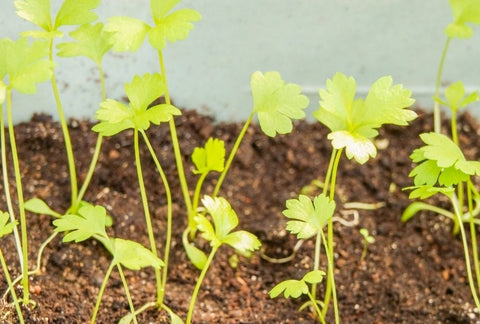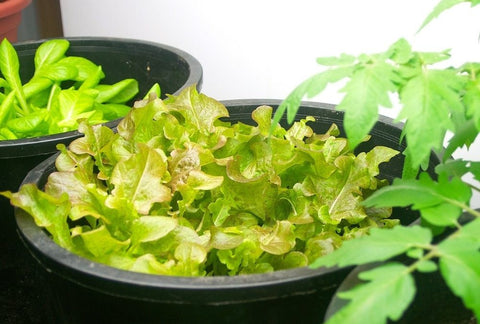Celery was initially used as medicine in the treatment of toothache, insomnia, hypertension, anxiety, arthritis, rheumatism, and purifying the blood. Ancient Romans used celery as an aphrodisiac.

Timing
Sprouts in 2-3 weeks. Harvest from Month 3+ on.

Part sun
Equivalent of 4+ hours of direct sun [DLI of 12+ mol/m²/day].

Care
Beginner-friendly. You’ll sprout, thin, and harvest.
Best Celery varieties to grow inside.
There are 3 types of celery: celeriac, leaf or self-blanching, and the most common one, stalk or Pascal celery. Below is a quick guide for you on the most appropriate ones to grow indoors:
Celebrity
Self-blanching
It has a mild, sweetish, aromatic taste. This is a self-blanching variety with long stalks.
Simply SeedConquistador
Stalk
It is early celery that produces full, upright heads packed with crisp, flavorful stalks
Johnny’s Seeds
Best Setup for Celery Plants
You’ll need:
Planter:
Ceramic Self Watering Planter (preferred) or pot that is at least 8″ / 1 gal.
Soil:
Standard Potting Mix
Plant Food:
Balanced Blend. This should be equal parts nitrogen, phosphorus, and potassium (with NPK numbers like 10-10-10).
Grow Light:
A strong grow light that can give the equivalent of 4+ hours of direct sun [DLI of 12+ mol/m²/day].
Jump to: Our product recommendations
Preparing your Planter & Watering Schedule for Celery
Celery plants do well in moist soil conditions. If the soil dries out completely the roots will die back and it will be tough for the plant to recover. On the other hand, if the roots are exposed to standing water for too long, they can rot.
A Ceramic Self Watering Planter filled with a standard potting mix self-regulates to keep the soil at consistent moisture for your plant to thrive (and no watering guesswork for you).
To set one up:

- Fill up the planter with dry soil from the bag, gently tamping down the top.
- Dump the soil into a large mixing bowl and add water until the soil is moist, but not sopping wet (about ½ Cup)
- Mix in 1 tablespoon of the Balanced Blend Plant Food.
If you are using a regular pot instead, it should be a little bit bigger (at least 8″ / 1 gal and will need drainage holes to prevent it from being over watered. Let the top of the soil dry out between watering.
Starting your Celery: Seed vs Cutting vs Nursery Plant
New Celery plants can be started from seed (preferred), propagated from an established plant, or purchased live at many garden centers. We like starting from seed the best because it’s quicker than propagating from a cutting however they transplant just fine – so starting with a live starter plant can speed up your time to harvest.
How to Plant Celery seeds

Celery grows quickly from the seed. Plant 5 sites in an 8″ / 1 gal container. In larger containers, space sites 2″ apart. For each site press 2 seeds into the surface. Keep the soil warm ( 60-75°F, ideally 65°F). Sprouts typically appear in 10 days but can be as quick as 7 days or as long as 21 days depending on your conditions.
How to Transplant Celery

Live starter plants give you a big jump start on your first harvest. When you’re in a garden center – pick the bushiest plant available (tall and lanky ones will be weak growers) and give it a good inspection for pests. Leaves should be dark green without holes, spots, or curled edges. A best practice is to actually “quarantine” your plant for about a week after bringing it home to make sure it’s free and clear of ride-on pests.
Ensuring it’s pest and disease-free it’s time to transplant your seedling into its final home.
- Remove some soil from its final planter – leaving enough space for the bottom of the seedling to be just higher than the soil surface.
- Hold on to the base of the stem with one hand, and turn the pot over while gently pulling the seedling. Giving the pot a few squeezes can help dislodge it.
- Place in its final container and fill around it with soil so that it’s tight, but not compacted.
Where to grow your Celery plants
Out of all edible plants, Celery plants have some of the lowest light needs – but they still need to be in a very bright place that gets at least 4+ hours of direct sunshine. While you might be lucky enough to have a bright windowsill that works, most of us need to use a grow light (especially during the winter). For an introduction to grow lights, head over to our post on grow lights for indoor gardeners. We’ve also got a buying guide for screw in types, but to keep things simple in this guide, we’ll just provide directions for the 24W Screw in Bulb by Sansi, which we think is a good middle-of-the-road option.

How bright should your grow light be?
Celery plants need the equivalent of 4+ hours of direct sunlight [DLI of 12+ mol/m²/day] to grow their best. In order to provide an equivalent amount with a grow light, it needs to be pretty bright! The 24W Sansi bulb should be placed 6 inches away from the top of the plant. This will give your PPFD (the standard measure of brightness) of 500 μmol/m²/s.
How many hours per day do your Celery plants need under a grow light?
Celery plants are known as “day-neutral” and can grow under a range of daylight lengths. In order for them to get enough light, we recommend setting up a timer to leave it on for 8+ hours per day.
Extend your harvest by keeping the Temperatures Cool
Celery is known as a “cool weather crop.” If it senses warming temperatures it will “bolt” – send up flowers and become bitter in the process. Where you plant them can have some effect on the temperature – lower positions on a growing rack, ceramic planters, and hydroponics with air bubblers tend to run cooler. It’s best to avoid windows that get really hot (like bay windows)
Week 2-3: Check for Sprouts
You could see seedlings in as little as 7 days (though 10 days is more typical). If it’s been 21 days and you still don’t have any sprouts, it’s likely that your setup is too cold.
Week 3: Thin Your Seedlings

Thin your planter to only have 1 seedling per site – leaving the largest plant. If you are using the recommended planter (at least 8″ / 1 gal) this will mean you’ve got 5 plants after thinning. By getting rid of the smaller seedlings, you’re allowing the biggest and strongest one to flourish by reducing its competition for water, food, and space.
If your seedlings are under 1 inch, stretching out, or folding over, it’s likely that they don’t have quite enough light.
Month 3+: How to Harvest Celery
Just as you did with your first prune, pick the outer leaves as needed, always leaving at least 1/3rd of the plant left to regenerate.
Year 2+: End of Life
Celery is a cool-season biennial crop – meaning it will keep producing for 2 years as long as you keep the temperatures from getting too warm. Eventually, it will form flowers and get bitter – this means it’s time to take it down and start over.
Shop This Blog
The right supplies can take the guesswork out of caring for your plants – and turn care from a daily to weekly routine. Through our grow tests, we’ve found these products to produce the best indoor Celery (and also have simple maintenance). Plants are adaptable and can grow in many different conditions, so they are by no means necessary if you already have other supplies.
Best Containers for Celery: Ceramic Self Watering Planters
Plants thrive on consistent moisture but can suffer if they’re waterlogged. A semi-porous ceramic self regulates ideal conditions. Our favorite is the COSWIP planter. Runner up is XS Self Watering Planter by Wet Pot.
Best Soil for Celery: Standard Potting Mix
Celery likes a rich and moist root zone – so you are best off with a standard potting mix – we like this Organic Mix by Espoma.
Best Nutrients for Celery: Balanced Blend
Celery likes nutrients that are equal parts nitrogen, phosphorus, and potassium (with NPK numbers like 10-10-10). For a Balanced Blend, we recommend: Dr Earth All Purpose
Best Light for Celery: DIY or Soltech
There is a very small chance that you have the bright windows needed to grow these without a grow light. If you are looking for a higher-end option – we love the Aspect Light by Soltech. For a more affordable option, a DIY setup using a 24W Screw-in Bulb by Sansi with a Clamp Light and Mechanical Timer works well too. Check out our complete guide on a DIY setup for less than $40 or our buying guide for screw in bulbs.










There are no comments for this article. Be the first one to leave a message!